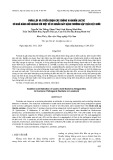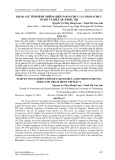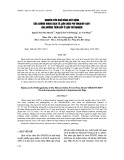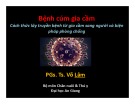
1
Chương 5: Chăn nuôi thú y & sức kh e ỏ
cộng đồng

2
Thú y & Sức kh e Cộng đồngỏ
Tác đ ng 2 chi u:ộ ề
Môi tr ng ườ s c kh e và năng su t v t nuôiứ ỏ ấ ậ
các y u t khí h u, môi tr ng (không khí, n c)ế ố ậ ườ ướ
các y u t v qu n lý (thi t k chu ng tr i, v sinh, qu n lý d ch ế ố ề ả ế ế ồ ạ ệ ả ị
b nh)ệ
Chăn nuôi - thú y môi tr ng & s c kh e con ng iườ ứ ỏ ườ
ô nhi m môi tr ng: không khí, n c, đ tễ ườ ướ ấ
lan truy n m m b nh (zoonoses)ề ầ ệ
an toàn th c ph m (ng đ c th c ph m, các ch t t n d )ự ẩ ộ ộ ự ẩ ấ ồ ư

3
Thú y & sức kh e cộng đồng- ỏVPH
Góp ph n nâng cao ầch t l ng s ngấ ượ ố con ng i qua hi u bi t & th c ườ ể ế ự
hành thú y
(FAO & WHO, The contributions to the physical, mental & social well being of humans through an understanding
and application of veterinary science).
S c kh e con ng i luôn g n v i s c kh e v t nuôi, thông qua:ứ ỏ ườ ắ ớ ứ ỏ ậ
• ho t đ ng chăn nuôi (ô nhi m môi tr ng, lan truy n m m b nh)ạ ộ ễ ườ ề ầ ệ
• v n chuy n (v t nuôi & các s n ph m c a chúng)ậ ể ậ ả ẩ ủ
• th c ăn (th t, tr ng, s a)ứ ị ứ ữ
• qu n áoầ
• thú c ngư

4
Thú y & sức kh e cộng đồng- ỏVPH
- Liên quan đ n s hi u bi t, phòng ng a & ki m soát:ế ự ể ế ừ ể
an toàn th c ph mự ẩ (food safety)
các b nh truy n lây gi a đ ng v t & ng iệ ề ữ ộ ậ ườ (zoonotic diseases)
- ng đ c th c ph m, n c u ngộ ộ ự ẩ ướ ố
- ti p xúc (chăn nuôi, thú y, thú c ng)ế ư
- môi tr ng (không khí, n c, đ t)ườ ướ ấ
- truy n b nh qua các v t ch trung gianề ệ ậ ủ

5
An toàn thực ph mẩ
- ATTP là 1 trong các v n đ quan tr ng nh t trong vi c: ấ ề ọ ấ ệ
b o v s c kh e con ng iả ệ ứ ỏ ườ
nâng cao ch t l ng s ngấ ượ ố
- “Food chain” là 1 m t xích quan tr ng trong vi c b o đ m VSATTP:ắ ọ ệ ả ả
t khâu s n xu t – ch bi n - phân ph i – tiêu dùngừ ả ấ ế ế ố
Đòi h i s tham gia c a m i ng i:ỏ ự ủ ọ ườ
- ng i s n xu t - kinh doanh – ch bi n - phân ph i - ườ ả ấ ế ế ố
- các c quan qu n lý & ng i tiêu dùngơ ả ườ

![Bệnh trên bò: Tài liệu một số bệnh thường gặp [A-Z]](https://cdn.tailieu.vn/images/document/thumbnail/2025/20250726/kimphuong1001/135x160/9451753499042.jpg)
























